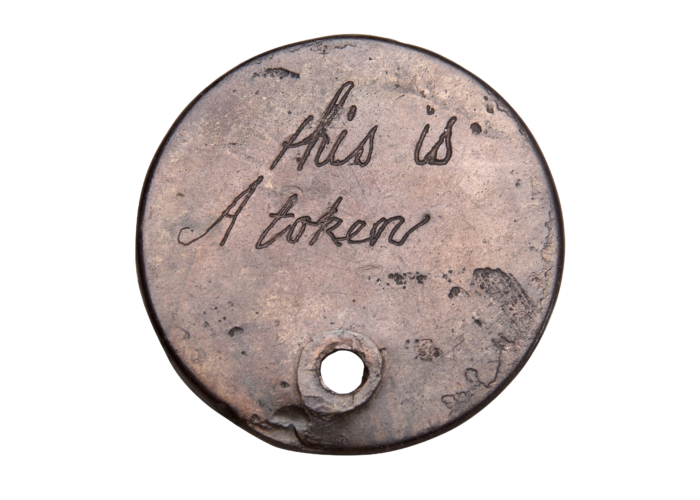Tokens given by mothers to their children on leaving them at the Foundling Hospital
Theme: The impact of industry, Economic and technological revolution
This is a selection of tokens from mothers who, unable to keep their babies, left them at the Foundling Hospital in London. They highlight the plight of single mothers and destitute families unable to care for their children and are a poignant reminder of the growing poverty crisis as cities became more heavily industrialised and workers more mobile during the Age of Revolution. Many babies were left anonymously by their mothers, along with a token to identify them, in the hope that they might be reunited in the future.
The Foundling hospital in London was established by Thomas Coram in 1741. He had been shocked to see babies and children abandoned and dying on London’s streets. At that time, childbirth outside of marriage was frowned upon, and there was very little help for unmarried mothers, many of whom had become pregnant through no fault of their own – through ignorance, accident, or through force.
As the population of first London and later many other industrialising cities grew, poverty increased beyond the capacity of outdated parish welfare systems, and so did the numbers of mothers forced to abandon their children. One of the Government’s ‘solutions’ was the Poor Law of 1834, designed more for taxpayers than for victims of poverty. It insisted that the able-bodied poor would only receive relief if housed in workhouses. Here they were clothed and fed and children received some elementary schooling. But conditions were appalling and disease was rife. Families were often split up and ‘inmates’ had to work long hours doing manual work such as laundry or breaking rocks.
Overseen by a new Poor Law Commission, they became known as ‘prisons for the poor’ and the subject of major national scandals. Most girls left at the age of thirteen to work in factories, laundries or in large houses as servants. It was not uncommon for these young girls to be exploited by their employers and many ended up on the streets, turning in desperation to prostitution in order to feed themselves.
The image of destitute children came to epitomise the Age of Revolution and the subsequent Victorian period. Prejudices against unmarried mothers continued well into the 20th century and it was not until the introduction of the welfare state in 1945 that the situation really began to improve. Coram continues to support vulnerable children and their families today.
Did you know..?
The artist William Hogarth and the composer George Frideric Handel helped establish the Foundling Hospital as one of London’s most fashionable venues. Hogarth encouraged leading artists of the day to donate work and Handel conducted benefit concerts of Messiah in the Hospital’s chapel.
Use our Classroom resources to investigate this object and the Industrial Revolution further.
Highlights:
- Using objects, artworks and other sources to find out about the past
- Introducing the Age of Revolution
And much more…
Sources & acknowledgements
This object description and its related educational resources were researched and written by our team of historians and education specialists. For further information see the item’s home museum, gallery or archive, listed above.
-
Did you know..?
The artist William Hogarth and the composer George Frideric Handel helped establish the Foundling Hospital as one of London’s most fashionable venues. Hogarth encouraged leading artists of the day to donate work and Handel conducted benefit concerts of Messiah in the Hospital’s chapel.
-
Education overview
You can access a range of teachers resources related to this object and more on our education page.
Please also see our glossary of terms for more detailed explanations of the terms used.
-
Curatorial info
- Originating Museum: Foundling Museum, London
- Production Date: 18th Century
- Material: Fabric and metal
- Original record
-
Use this image
You can download this image for personal and educational use but please take note of the license type and rights holder information.
- Rights Holder: Foundling Museum, London
- License Type:






